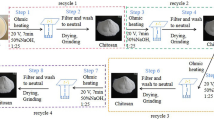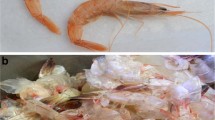Abstract
Piezoelectric quartz crystal impedance analysis technique was applied to study the chitosanolytic activity of pepsin. The method is based on the viscosity-density reduction of chitosan solution during the enzymatic degradation process. Experiments examined the time courses of the variations of motional resistance (ΔR1) for a quartz crystal. By comparing the ΔR1 response curves under different degradation conditions, the effects of pH, temperature, enzyme and substrate concentration on the chitosanolytic activity of pepsin was investigated in detail. The results suggest that the optimum pH and temperature were 4.6 and 55°C, respectively. Increasing aptly the enzyme or substrate concentration was in favor of the degradation of chitosan. Moreover, the influence of the degree of deacetylation (DD) on the enzymatic degradation was studied. The result indicates that chitosan with a lower DD was easier to be degrade compared with chitosan with a higher DD. Also, it was found that there was a good linear relationship between the ΔR1 response and the DD value. The regression equation was ΔR1 = 0.058 × DD - 6.795 and the correlation coefficient was 0.987.
Similar content being viewed by others
References
M. Alexandra, V. Christophe, and D. Alain, Biomaterials, 2005, 26, 1633.
W. G. Seo, H. O. Pae, N. Y. Kim, G. S. Oh, and I. S. Park, Cancer Lett., 2000, 159, 189.
C. Q. Qin, Y. M. Du, L. Xiao, Z. Li, and X. H. Gao, Int. J. Biol. Macromol., 2002, 31, 111.
F. Shahidi, J. K. V. Arachchi, and Y. J. Jeon, Tre. Food Sci. Technol., 1999, 10, 37.
E. Belamie, A. Domard, and M. M. Giraud-Guille, J. Polym. Sci., Part A: Polym. Chem., 1997, 35, 3181.
F. Tian, Y. Liu, K. Hu, and B. Zhao, Carbohydr. Polym., 2004, 57, 31.
R. Czechowska-Biskup, B. Rokita, S. Lotfy, P. Ulanski, and J. M. Rosiak, Carbohydr. Polym., in press.
F. S. Kittur, A. B. Vishu Kumar, and R. N. Tharanathan, Carbohydr. Res., 2003, 338, 1283.
K. M. Vårum, H. K. Holme, M. Izume, B. T. Stokke, and O. Smidsrød, Biochim. Biophys. Acta, 1996, 1291, 5.
A. V. Ilyina, V. E. Tikhonov, A. I. Albulov, and V. P. Varlamov, Process Biochem., 2000, 35, 563.
M. Yalpani and D. Pantaleone, Carbohydr. Res., 1994, 256, 159.
S. J. Martin, V. E. Gransdtaff, and G. C. Frye, Anal. Chem., 1991, 63, 2272.
M. Yang and M. Thompson, Anal. Chem., 1993, 65, 1158.
T. Zhou, L. H. Nie, and S. Z. Yao, J. Electroanal. Chem., 1990, 293, 1.
D. A. Buttry and M. D. Ward, Chem. Rev., 1992, 92, 1355.
S. F. Zhang, W. Z. Wei, H. Tao, and Y. A. Mao, J. Enzyme. Inhib. Med. Chem., in press.
J. Z. Zhang, W. Z. Wei, H. Peng, Y. A. Mao, and S. F. Zhang, Enzyme Microb. Technol., 2002, 31, 392.
Y. A. Mao, W. Z. Wei, D. L. He, L. H. Nie, and S. Z. Yao, Anal. Biochem., 2002, 306, 23.
L. M. Furtado, H. Su, M. Thompson, D. P. Mack, and G. L. Hayward, Anal. Chem., 1999, 71, 1167.
H. Muramatsu, E. Tamita, and I. Karube, Anal. Chem., 1988, 60, 2142.
Author information
Authors and Affiliations
Corresponding author
Rights and permissions
About this article
Cite this article
Tao, H., Wei, W., Mao, Y. et al. Study on Degradation Characteristics of Chitosan by Pepsin with Piezoelectric Quartz Crystal Impedance Analysis Technique. ANAL. SCI. 21, 1057–1061 (2005). https://doi.org/10.2116/analsci.21.1057
Received:
Accepted:
Published:
Issue Date:
DOI: https://doi.org/10.2116/analsci.21.1057




